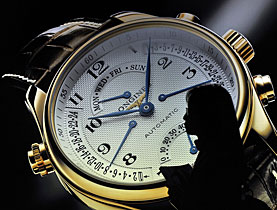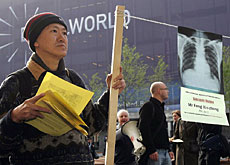Fabergé hatches illustrious rebirth in Geneva

It was a renaissance waiting to happen. The ghost of Peter Carl Fabergé, goldsmith to Russian royalty, has been conjured up and his name tied to a new jewellery line.
The Fabergé brand name has been relaunched by private investors and family members, and Fabergé’s only boutique opened on the shores of Lake Geneva.
It is the first shop to open since 1917 when the Russian Revolution brought an end to the House of Fabergé, the celebrated jewellers who created fantastical Imperial Easter Eggs for Tsar Nicholas II, among others.
The Bolsheviks seized the Fabergé workshops at the time, and the family fled to Germany and then to Switzerland, where the master craftsman died in 1920.
In the years that followed, the family lost the rights to their name and saw it used to build a perfume empire that was later sold to Unilever for $1.55 billion in 1989 (SFr1.63 billion at present day exchange rates).
Private equity firm Pallinghurst Resources finally bought the name for an undisclosed sum in 2007, with a view to reuniting the brand with the family and associating it once again with high-end jewellery.
“The opportunity arose because some particularly enlightened investors discovered that the Fabergé trademarks were a little bit unloved and a little bit ignored,” Fabergé CEO Mark Dunhill says, sitting back into a sofa in the Art Nouveau lounge at the Geneva boutique.
“I think Fabergé is one of the great magical names in the world of beautiful objects. We see ourselves as custodians of a very famous and illustrious house. We are in a sense overseeing a renaissance,” Dunhill mused.
The new owners decided that in order to breathe new life into the brand, they would have to break from tradition and come up with an entirely different kind of collection. That meant that none of the famous eggs would be designed for now.
Geneva, the rich hub
Jewellery designer Frédéric Zaavy was brought on board with a brief to reinvent the brand’s French romanticism and Russian heritage with a modern twist. The first collection was unveiled earlier this year in Paris, with pieces ranging in price from SFr45,000 for a ring to SFr8.9 million for a bracelet with 5,000 diamonds, rubies, opals and sapphires. Big spenders wanting to pick up an item must either travel to Geneva or shop online.
The Geneva boutique is nestled within the city’s luxury district. Visitors must pass through two security doors before entering the shop’s futuristic inner sanctum with its gleaming wood panelling and swathes of regal purple – an understated contrast to the brilliant colours of the jewels.
Geneva was seen to be the best location in the world for a shop, being at the heart of the luxury watch and jewellery industries and as a hub of the world’s private banking and finance industry.
“In Geneva airport at any one time there are more private planes parked than anywhere else in the world. It provides a very convenient access point for our clients to come and see us,” says Dunhill, who has spent 17 years working with luxury goods.
Although the flagship boutique is in Geneva, the brand’s bigger window to the rest of the world is its website, where customers can inspect high-resolution images of the jewels and chat with a salesperson by webcam. Once customers have made their choice, sellers will home deliver the jewels anywhere in the world.
Dunhill says the idea of basically selling such high-ends goods via a website is a world first. He adds there is no risk of depersonalising the experience of buying such pricey jewellery as the technology will appeal to the attitudes of “discerning consumers around the world”.
Bridging the gap
Just across the border in France lives Fabergé’s great-granddaughter Tatjiana, who is now 79 and has been instrumental in helping the company draw a line between the brand’s past and present.
She sits on a heritage council, together with another of Fabergé’s great-granddaughters, Sarah, and another expert on the family history. As a “living archive” they have contributed photographs, stories, know-how and even lent a Russian-made bust of their ancestor to the Geneva shop.
“I think the most difficult task of all was bridging the time between 1917 and 2009 and picking up where the past was so glorious and came to a very sudden halt,” explained Katharina Flohr, the company’s creative director, a previous fashion director for Russian Vogue and jewellery and fashion editor for Tatler magazine.
To gain inspiration for the collection she went on a road trip to St Petersburg with Tatjiana Fabergé and designer Zaavy to meet museum curators, see works up close and soak up the Russian ambiance.
Full-circle
“We could not afford to reproduce what was done in the past because that, I think we all agree, is unsurpassed, and the level of craftsmanship that was applied in those days was just so exceptional,” she said.
“We want to bring back the art of making beautiful jewellery. First and foremost we have to create products that are relevant to today and things that are beautiful today.”
She adds that plans are being hatched for Fabergé best-known creation, the Imperial eggs. “We will come back to the eggs at some point in time. It’s a signature piece for Fabergé.”
As for Tatjiana Fabergé, she has long dreamt of reviving her ancestor’s legacy. Although dubious about the relaunch at first, having seen various attempts to regenerate the name, she thinks her ancestor would approve of the new collection.
“It is rare to see history come full-circle during one’s lifetime. I am delighted that the Fabergé name has been brought back in from the cold,” she said.
Jessica Dacey in Geneva, swissinfo.ch
1846 – Peter ‘Carl’ Fabergé is born in St Petersburg to goldsmith and jeweller Gustav and Charlotte Fabergé.
1860 – Studies at the Dresden Arts and Crafts School.
1864 – Carl does a Grand Tour of Europe, gets tuition from respected goldsmiths.
1872 – He returns to St Petersburg and marries Augusta Jacobs. Family firm starts restoring masterpieces in the Hermitage Museum.
1881 – Carl takes charge of the business.
1882 – Tsar Alexander III cites firm’s work as examples of superb Russian craftsmanship.
1885 – The Emperor commissions an Easter egg for his Empress. The House becomes a goldsmith by appointment to the Imperial Crown.
1886 – The Tsar commissions a second Easter egg.
1900 – The business becomes the largest jewellery firm in Russia.
1914 – Outbreak of the Great War leads to a fall in demand for luxury goods.
1918 – The House of Fabergé is nationalised and its stock confiscated.
1918 – Carl leaves St Petersburg for Riga and heads to Germany. His son Eugène and wife flee to Finland.
1920 – Eugène brings his father to Switzerland where other members of the family have taken refuge. Carl Fabergé dies in Pully.
1924 – Eugène and his brother Alexander establish Fabergé & Cie, which trades in objects by the House of Fabergé.
1937 – Sam Rubin, an American of Russian descent, starts a perfume business. He brands his perfumes Fabergé and forms Fabergé Inc. This is done without the family’s permission.
1951 – The Fabergé family settle out of court to avoid high legal fees. Rubin pays $25,000 to use their name solely for perfume.
1964 – Rubin sells Fabergé Inc to cosmetic company Rayette for $26 million.
1984 – Fabergé Inc is sold for $180 million.
1989 – Unilever buys Fabergé Inc for $1.55 billion. Registers the Fabergé name as a trademark for a range of merchandise and grants licenses to third parties to produce various Fabergé branded products.
2007 – Pallinghurst Resources buys the Fabergé trademarks and licenses in order to establish Fabergé as luxury goods brand and reunite the name with members of the family. Fabergé Limited is formed.
2009 – Geneva flagship boutique opens.

In compliance with the JTI standards
More: SWI swissinfo.ch certified by the Journalism Trust Initiative















You can find an overview of ongoing debates with our journalists here . Please join us!
If you want to start a conversation about a topic raised in this article or want to report factual errors, email us at english@swissinfo.ch.